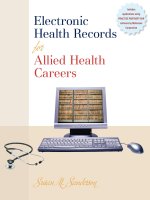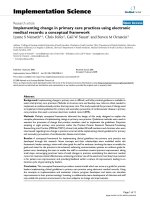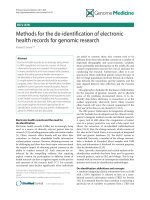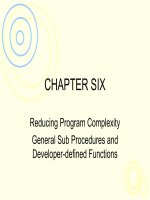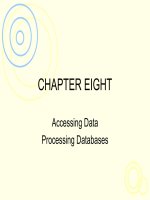Lecture Nursing documentation using electronic health records: Chapter 1 - Byron R. Hamilton, Mary Harper, Paul Moore
Bạn đang xem bản rút gọn của tài liệu. Xem và tải ngay bản đầy đủ của tài liệu tại đây (636.44 KB, 26 trang )
1-1
Chapter 1
An Introduction to Electronic
Health Records
McGrawHill
© 2012 The McGrawHill Companies, Inc. All rights reserved.
1-2
Chapter 1 Content
1.1 Brief history of electronic health records
(EHRs)
1.2 History of standards development for the
EHR and nursing’s role in their
development
1.3 Certification bodies for the EHR
1.4 Benefits of the EHR
1.5 Government involvement in the EHR
1.6 Role of nursing informatics in healthcare
1-3
L.O. 1.1 The EHR History
1-4
L.O. 1.1 The EHR History
• Impetus for development
– Quality patient care
• 1960s
– First EMR programs
– First electronic databases
1-5
L.O. 1.1 The EHR History
• Terms and Definitions
– CPR:
– EMR:
– EHR:
– CCD:
– PHR:
Computer-Based Patient Record
Electronic Medical Record
Electronic Health Record
Continuity of Care Document
Personal Health Record
1-6
L.O. 1.1 The EHR History
• Point of care documentation
• Modes of Data Entry
– Keyboard
– Voice recognition
– Handwriting recognition
– Templates and data selection
– Touch screens
• COWs/WOWs
1-7
L.O. 1.1 The EHR History
• Security and reliability
– Local area network (LAN)
– Internet
– Intranet
– Data encryption
– Application server provider (ASP)
1-8
L.O. 1.2 Development of EHR
Standards
1-9
L.O.1.2 Development of EHR
Standards
• Barriers to EHR adoption
– Cost
– Organization
– Lack of unified standards, functionality, and
interoperability
1-10
L.O.1.2 Development of EHR
Standards
• IOM’s Committee on Data Standards for
Patient Safety – 2003
– Identified key competencies
– Became foundational benchmark for EHR
development and programming
• Consolidated Health Informatics (CHI)
standards - 2004
– Enabled agencies to share information
– Common clinical vocabularies
– Standard methods of transmission
1-11
L.O.1.2 Development of EHR
Standards
• Role of nursing in standards development
– Promotes standardization to identify nursing’s
contribution to patient care
– Promotes research
– Promotes identification of relationships among
nursing interventions and outcomes
1-12
L.O.1.2 Development of EHR
Standards
• Technology Informatics Guiding
Educational Reform (TIGER) Initiative
– Goal to ensure nursing input into the
standardization process for EHRs
– Calls for agreement on the standardized
nursing terminology to promote
interoperability
• Standardized nursing language examples
– NANDA-I, NOC, NIC
– ICNP
1-13
L.O. 1.3 EHR Certification Agencies
1-14
L.O. 1.3 EHR Certification Agencies
• The Certification Commission for Health
Information Technology (July 2004)
– Mission: To accelerate the adoption of health
information technology by creating an
efficient, credible, and sustainable product
certification program
1-15
L.O. 1.3 EHR Certification
Agencies
• CCHIT
– Creates inspection process for:
• Ambulatory care EHRs for the office-based
healthcare provider
• Inpatient EHRs for hospitals and health
systems
• Network components through which EHRs
interoperate and share information
1-16
L.O. 1.3 EHR Certification
Agencies
• Office of the National Coordinator for
Health Information Technology (ONC) 2004
– Purposes
• Serve as a resource to the entire health
system
• Support the adoption of health information
technology
• Promote a nationwide health information
exchange in order to improve healthcare in
the United States
1-17
L.O. 1.4 Benefits of The EHR
1-18
L.O. 1.4 Benefits of The EHR
• Enhanced accessibility to clinical
information
• Patient safety
• Quality patient care
• Efficiency and savings
1-19
L.O. 1.5 Government
Involvement in the EHR
1-20
L.O. 1.5 Government Involvement
in the EHR
• President George W. Bush (2004)
– Called for universal EHRs by 2014
“By computerizing health records, we
can avoid dangerous medical mistakes,
reduce costs, and improve care.”
1-21
L.O. 1.5 Government Involvement
in the EHR
• Medicare Improvements for Patients and
Providers Act of 2008 (MIPPA)
– Positive incentives for practitioners who use
e-prescribing
– Penalties for practitioners who do not eprescribe after 2014
• Surescripts
– National clearinghouse for e-prescribing
1-22
L.O. 1.5 Government Involvement
in the EHR
• American Recovery and Reinvestment Act
(ARRA) - 2009
– The Health Information Technology for
Economic and Clinical Health (HITECH) Act
• $20 billion to aid in the development of a
healthcare infrastructure and to promote adoption
and use of health information technology, including
EHRs
• Requires “meaningful use” of a “certified” EHR
• Provides bonus/incentive payments
1-23
L.O. 1.6 Nursing Informatics
1-24
L.O. 1.6 Nursing Informatics
• Florence Nightingale
– Recognized the need for standardization of
nursing language to facilitate communication
and enhance quality care
• Harriet Werley
– first provided nursing input for computer use
in the healthcare arena in the 1950s
• 1970s: Nursing applications for computers
began to be developed
1-25
L.O. 1.6 Nursing Informatics
• 1973
– North American Nursing Diagnosis Association
(NANDA)
– Developed initial set of nursing diagnoses
• 1980s
– Development of personal computers
– Nursing informatics courses
• 1994
– Nursing informatics recognized as nursing specialty
– Scope and standards of nursing informatics practice
developed
